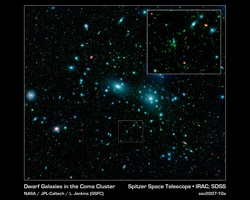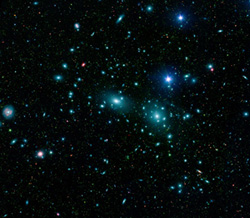In a very short time, the Spitzer Space Telescope discovered more than a thousand dwarf galaxies that were previously unknown to scientists in a huge cluster of galaxies, a discovery that may explain phenomena related to gravity and galaxies
 In the photo: artificial color photograph of the Kuma Barnica cluster center that combines infrared and visible light photographs, which helped to reveal thousands of pale objects (in green).
In the photo: artificial color photograph of the Kuma Barnica cluster center that combines infrared and visible light photographs, which helped to reveal thousands of pale objects (in green).
Follow-up observations showed that many of these objects, visible in the image as pale green spots, are dwarf galaxies belonging to the cluster. Two large elliptical galaxies, NGC 4889 and NGC 4874, dominate the center of the cluster. The attachment combines images in visible light taken by the digital sky scanner Sloan (blue color code) and in the long and short wave range of the infrared (visible in red and green colors respectively, as taken by NASA's Spitzer Space Telescope.
Despite their tiny size, dwarf galaxies play an important role in the evolution of the universe. Astronomers believe that they were the first galaxies to form, and they provided the building blocks for the larger galaxies. They are very numerous in the universe, and they serve as an important marker of the large-scale structure of the universe. Computer simulations of cosmic evolution have led scientists to hypothesize that the high-density regions of the Hikku, such as the giant clusters, may contain many more dwarf galaxies than astronomers have previously observed.
A team led by Lee Jenkins and Ann Hornshmeier, both from NASA's Goddard Space Flight Center in Maryland, used Spitzer to study the Coma Bernica cluster, a vast concentration of galaxies about 320 million light-years away in the direction of the constellation COMA. The cluster contains hundreds of previously known galaxies occupying a volume of 20 million light years in space.
Jenkins, Hornshmeier and their collaborators used data from the Infrared Camera Array (IRAC) on the Spitzer Space Telescope to study the center of the cluster. They also focused on the desired region in order to compare the density of galaxies in different regions and measure the environmental effects on the evolution of galaxies. They combined 228 different exposures of Spitzer, each lasting between 70 and 90 seconds into one composite covering 1.3 square degrees of the sky.

Pictured: This picture shows details of one of the dwarf galaxies in the Coma Bernica cluster. The composite combines visible light data taken by the Sloan Automatic Sky Scanner (in blue) and long and short wavelength images (red and green respectively) taken by Spitzer.
The team discovered almost 30 thousand objects whose catalog will be available to the astronomical community. Some of these galaxies are indeed in the floor cluster, but the team noticed that a significant proportion of the galaxies are background galaxies. They used a 4-meter diameter telescope at the William Herschel Observatory on the Canary Island of La Palma. Team member Braham Mobasher from the Space Telescope Science Center in Baltimore helped measure the distance to hundreds of galaxies in this field to estimate how many of them are actually members of the cluster.
A surprising number of galaxies turned out to be members of the Barnica cluster. Massten is about the same or even smaller than that of the Small Magellanic Cloud, the second largest satellite galaxy of the Milky Way. Jenkins estimates that between 1,200 and 30 pale objects are dwarf galaxies, many more than previously discovered. Given the fact that the observations cover only a small part of the cluster, the result is that the minimum number of dwarf galaxies in this cluster is about 4,000.
Spitzer made these discoveries possible thanks to the fact that he can scan large areas of the sky efficiently, observations in the infrared range in space can provide a deeper picture than the observations from the ground in the near infrared range because the background in these areas is 10,000 times darker than the background in visible light.
"Through Spitzer's capabilities, we can suddenly discover thousands of pale galaxies that we haven't seen before," says Jenkins. She presented the results of the study at the end of May at the American Astronomical Society meeting held in Honolulu, Hawaii. The article on the research will also appear in the Astrophysical Journal.
According to Jenkins, it is necessary to continue to analyze Spitzer's data, and with additional methods to find out the exact number of galaxies, Hornshmeier and her other colleagues are now performing in-depth spectroscopic measurements using a 6.5-meter telescope at the MMT Observatory in Arizona, and a 10-meter telescope at the Keck Observatory in Hawaii to find out Some of the faintest objects belong to the Koma cluster.
For information on the NASA website

4 תגובות
Thousands
Regular
Stunning,
Red galaxies, green stars
Looks like a painting
Thanks Yossi
Stunning,
Red galaxies, green stars
Looks like a painting
Thanks Yossi
It would be useful to give the following link:
http://antwrp.gsfc.nasa.gov/apod/ap070531.html
which appears in "NASA's Photo of the Day" and allows, even by enlarging by clicking on the image, to see the photo in maximum detail.